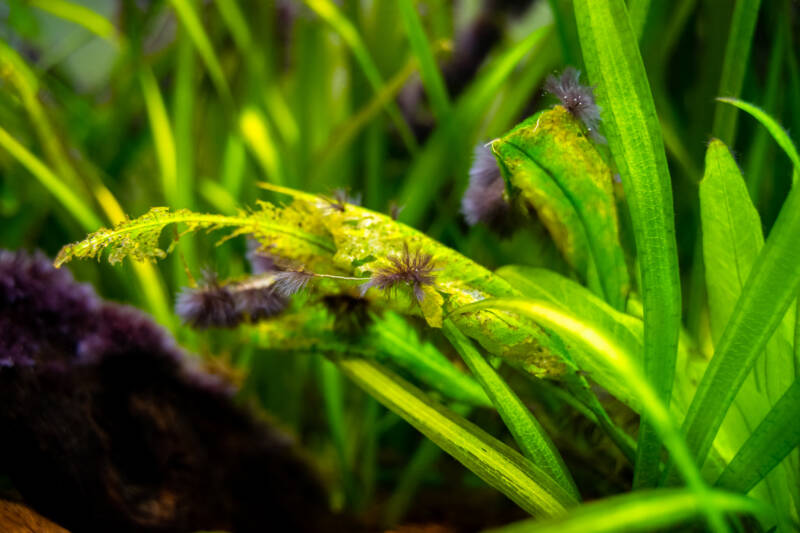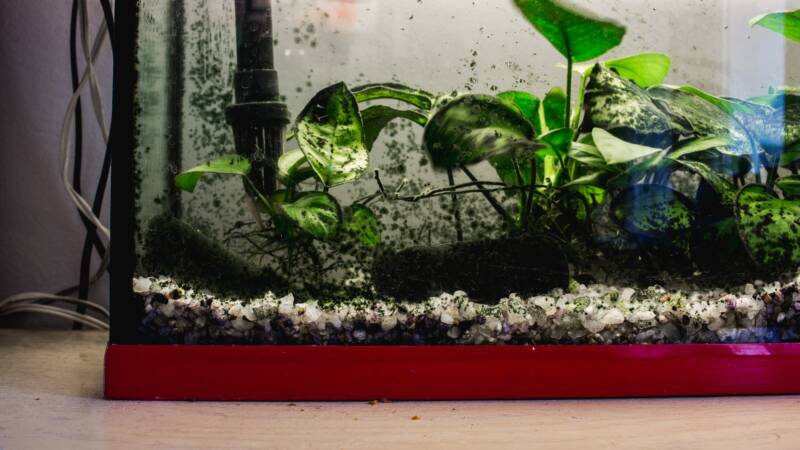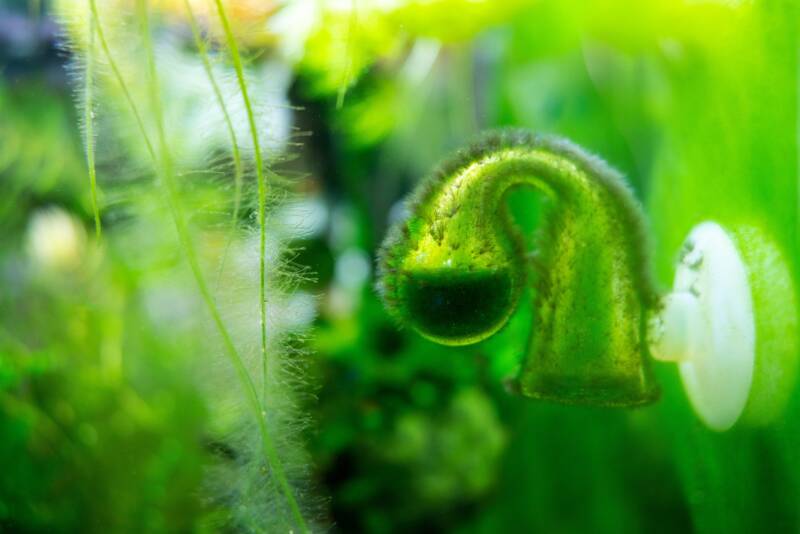What photosynthesizes and says “Arr”? Blackbeard algae!
Alright. You’re here for a reason. What is that furry, black substance sprouting on the edges of my anubias leaves?
Why does my driftwood look like it needs to shave? Do I need to call the Navy to deal with this pirate blight? It’s black beard algae (BBA).

Today we’ll talk about a couple of subjects related to BBA, including what it really is, where it comes from, and several techniques to deal with it.
[toc]
What is Black Beard Algae?
BBA, otherwise known as black brush alga, is actually a group of algae or genus named Audouinella. Audouinella contains over 41 species alone! (source)
Despite its name and appearance, BBA is a red alga, not unlike the unsightly staghorn algae. The remaining filaments, or hairs, turn red to reddish-brown when it dies off.
It appears initially as small pin-sized tufts of black filaments, almost anywhere.
In my experience, I find it on the edges of slow-growing leaves, like anubias or Java fern, where the leaves release waste from photosynthesis.

But it can appear on almost any aquarium surface, down to the substrate or your filter intake. BBA can take over an aquarium quickly if given the right conditions.
When BBA does take over, it presents as dense, flowing tufts of black, brown, grey, deep green, and even dark red.
It spreads and reproduces asexually in the home aquarium via fragmentation propagation.
BBA in the Wild
In nature, BBA is seen in some form or another in most waters in the world and is a very important part of its local ecosystems.
BBA is excellent at removing excess nutrients and pollutants from water. In lotic zones, you’ll find it in rivers, streams, and other areas containing moving waters.
BBA particularly enjoys water with low concentrations of carbon dioxide, or CO2, and an excess of phosphate, or PO4.
If you find a dense BBA forest naturally occurring somewhere, you’ll most likely find a plethora of fish and other fauna making their homes in it. BBA’s dense, long filaments create incredible cover for aquatic animals.
I’m sure you’re thanking me for the short middle school biology lesson, but you’re here for a reason.
But before we talk about removal and treatment of black beard algae, we need to understand why it’s in your aquarium in the first place.
Understanding how it got there and why your driftwood looks like an Ent from The Two Towers mixed with Aragorn will help you in the future.
Prevention is the best medicine, as they say.
Black Beard Algae Causes

Water Quality
Your tank is dirty. There. I said it. Unless you’re hoping to propagate BBA. Then, congratulations, because it’s pretty hard to actually encourage growth in.
BBA enjoys acidic, high PO4, and low CO2 environments.
The higher the amount of complex dissolved solids – the better, because BBA can break them down so much faster and greater than any traditional plants in your aquarium.
BBA uses all those complex compounds to grow and reinforce its dense filaments to make it inedible to traditional algae eaters in aquaria.
Nutrients and Fertilizers Excess
Your aquarium plants take all that they can when you dose them with all those nutrients and fertilizers and utilize it, but they can’t absorb everything.
All the remaining nutrients remain circulating in the tank, along with excess food and waste from your plants and animals.
This is a tasty morsel, just waiting to be absorbed by whatever tiny presence of algae is floating around from your new plants, snails, or even fish.
There are more than a couple of reasons to not add fish store water to your tank. Whatever nutrients aren’t being used in your aquarium, I can assure you, there’s an alga that utilizes it very successfully.
Overfeeding
Another one of those dastardly tendencies, especially in new fishkeepers, is overfeeding.
Realistically, your fish do not need to be fed every day. It leads to plump little fishies with all sorts of problems.
Fish don’t eat a giant processed meal every day in the wild, and personally, my fish don’t either.
I’ve had a very good experience, especially with my mature schooling fish like tetras and rasboras, with a day of fasting per week. This cuts down on fish and food waste and, anecdotally, leads to a longer lifetime.
If you’re breeding fish and raising juveniles, I would stray from fasting. However, mature fish handle it incredibly well.
Mature fish are also excellent at grazing and scavenging and will more than likely find something to snack on while they wait for their next meal.
Light Overuse
Algae love light. They are the top photosynthesizers in the world for a reason.
The longer a light stays on, the better algae get at photosynthesizing, especially in an aquarium with a lot of waste and other sources of nutrients.
BBA can continue growing as long as the light is on, unlike traditional aquarium plants, which store reserves of the required materials during rest for short bursts of highly productive photosynthesis.
Your aquarium realistically requires 10-12 hours of light per day at maximum.
I’ve had good results with two 4.5-hour lighting periods per day, excluding ramp-time for my lighting turning on and off.
Prevention
How to Correct Your Water Quality
Clean your aquarium more if you don’t want algae. It’s fairly simple but hard to execute.
Biweekly water changes of 25% at the BARE minimum for traditional planted aquariums, especially if you’re using a heavy fertilizing regimen.
Vacuum your substrate to remove fallen, unprocessed fish waste and decaying plant matter.
Rinse and squeeze out your filter media in aquarium water occasionally. They need it.
How to Deal With Overfeeding
If you’re uncomfortable with the idea of fasting your fish, please only feed your fish what they can consume in roughly a minute.
Fish are generally voracious eaters and will eat more than enough in that small amount of time.
If you see excess food drifting around your fish tank, you’re not only providing nutrients for algae and mold but a food source for all sorts of aquarium pests, like Malaysian trumpet snails or planaria.
How to Use the Light
One little additional tip in preventing BBA, and all sorts of other algae, is altering the photoperiod for your aquarium.
Light timers. A method explained by Diana Walstad in her wonderful book “ECOLOGY of the PLANTED AQUARIUM – A Practical Manual and Scientific Treatise for the Home Aquarist’ has given me very good results.
Without getting into too many details, aquarium plants are significantly better at starting and stopping photosynthesis than algae.
The algae’s photosynthesis process is significantly affected if you set your light timers to give at least a half-hour break in the middle of the day.
At the same time, your plants will continue to grow happily and healthily.
How to Fertilize
This is a very personal subject, the issue of many internet debates and flame wars in the days of yore on old forums and BBSs.
While in your LFS, I’m sure you’ve seen a man with a bleach-stained Sea-Chem shirt mumbling to himself in a scary-looking aisle filled with hundreds of bottles labeled with an unknowable chemical compound.
I don’t like living that way. Instead, I recommend an All-In-One aquarium fertilizer and root tabs.
If you can’t locate one or have a very specific fertilizing regimen in mind, please follow the directions on the bottle.
If following a strict dosing regimen, follow the dosing regimen and water change schedule.
Your plants can only consume so much. Anything leftover is wasted and eventually helps create the environment BBA thrives in.
Now finally, in all its glory, is the section telling you how to treat BBA.
Treating Black Beard Algae in the Aquarium
Here are a couple of options for directly treating BBA, listed in the most successful personal order.
If you don’t have success with prevention, and you absolutely must treat your aquarium, these are some of your options.
Hydrogen Peroxide Solution
Hydrogen Peroxide is very successful at SPOT treating BBA.
Proceed with caution! DO NOT DUMP hydrogen peroxide into your fish tank. Please.
If you see BBA developing on any plants or aquarium decorations, REMOVE them from the aquarium, and then bathe them in a 3% hydrogen peroxide solution for 1-2 minutes. Remove and rinse with dechlorinated water very well.
You’ll see the BBA turn white, pink, or red if successful.
You can manually scrape it or leave it for algae eaters to consume. Once BBA is dead, algivores will consume it.
Alternatively, you can spot-treat small areas within the aquarium with a syringe or turkey baster.
Squirt a SMALL amount of hydrogen peroxide directly onto the BBA. Exercise caution when spot treating.
Blackout Treatment
Blackout treatment is more of a general algae treatment and definitely helps the process of reclaiming an alga overridden aquarium.
Turn off all lights in your aquarium. Then, wrap it in a dark towel or blanket for 2-3 days, ensuring that gas exchange can still occur.
When you unwrap your aquarium, you’ll see that quite a bit of your algae has died off.
Your plants will be safe during this blackout period but may seem less vibrant afterward. This is okay. They’ll revitalize and return to their happy, healthy state in two to three days.
If you proceed with preventative measures after a blackout, you’ll see the BBA shrink and eventually disappear.
Flourish Excel
PLEASE READ BEFORE USING. Flourish Excel, by Seachem, is a form of bio-available liquid carbon.
I do not recommend regular dosing with this supplement because it’s a form of formaldehyde and can be dangerous to invertebrates, like snails and shrimp.
However, it does increase CO2 levels within the tank, creating an environment hostile to BBA.
Regular dosing over two weeks, along with using our previously discussed preventative measures, should see a reduction and eventual absence in BBA in your aquarium.
These have been the most useful techniques I’ve utilized in treating BBA.
Please do NOT attempt to manually remove it. Every little fiber you don’t remove finds a new place in your aquarium to seed and grow. That one small clump of BBA can turn into a vast field quickly.
I also recommend pruning any older leaves from slow-growth plants, like anubias and Java fern, that show BBA developing.
It’s significantly easier to prune an old, yellowing leaf than to treat BBA in an entire aquarium.
Conclusion
BBA is not the worst thing to happen in your aquarium and is very treatable.
Some aquarists even attempt cultivating BBA for its striking looks and easy cover for aquarium inhabitants. Good luck and happy fishkeeping!
Please feel free to leave any comments or questions below.
